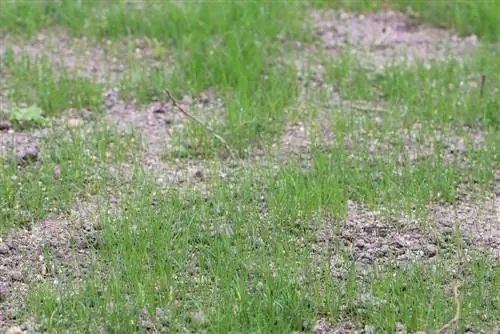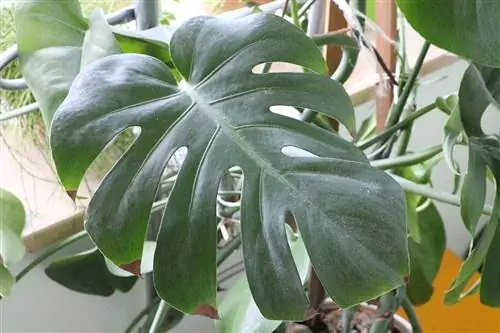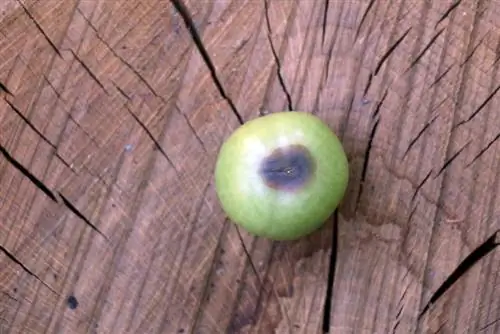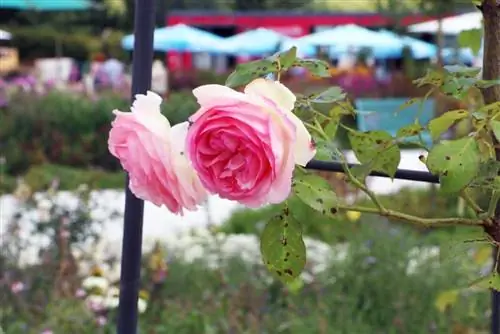- Author admin [email protected].
- Public 2023-12-17 03:39.
- Last modified 2025-06-01 06:48.
With knowledge of the cause, the brown spots can be easily remedied.
Brown spots due to lack of care
The most common reason for brown spots on the lawn is inadequate care. The unsightly spots can be due to drying out - the lawn can burn in direct sunlight and high heat. But waterlogging can also cause the stains. This can be remedied by regular scarifying of the lawn, which loosens it, ventilates it and at the same time ensures that the rainwater can drain off easily again. In addition, the lawn should be cut regularly, as blades of grass that are too long can cause it to turn brown.
Brown discoloration due to fungal attack
Fungals in lawns are widespread and occur primarily where the lawn is permanently moist. There are many different types of fungi, and red-tipped fungi are primarily responsible for brown spots in the lawn. The name can cause confusion - the affected lawn does not show red spots, but rather straw-yellow to brownish spots. The causes of red tipping are increased moisture in the lawn or stressful situations such as a lack of nutrients, incorrect irrigation and extremely high temperatures.
The red tip doesn't cause the lawn to die - it just looks extremely unsightly. The brown color of the lawn usually disappears on its own as soon as the moisture balance in the soil is correct again. However, if this fungal infestation occurs due to a nutrient deficiency, a good lawn fertilizer should be used.
The following methods effectively prevent fungal infestation:
- Lawn fertilizer: The lawn area should be adequately supplied with nutrients.
- Good ventilation: It is important to ensure that the lawn is well ventilated so that it can grow he althily and beautifully.
- Windbreak: Walls or dense hedges block the wind and thus promote the spread of fungi; Likewise, all leaves should be collected from the lawn in autumn.
- Water correctly: Moisture promotes the spread of fungi in the lawn. Weekly, long watering has a preventative effect. The water can penetrate deep into the ground while the lawn itself dries quickly.
The meadow snail may be to blame
Spring is here and the lawn is showing brown spots? The meadow fly larvae may be to blame. These larvae colonize the area just below the turf, eating the roots of individual grasses. In the period from August to September, the female meadow gnats lay their eggs in the lawn, from which the larvae hatch after four to six weeks. These burrow into the turf and usually start feasting on the grass roots as early as autumn.
In April and May, after overwintering, the big feeding begins, during which the larvae, which are around four centimeters long, even feed on the leaves of the lawn grass. The grass roots damaged by the larvae cause the lawn to turn partially yellow-brown before it finally dies. The infestation of meadow flies can be distinguished from a fungal disease by the fact that in this case the individual grasses do not have any deposits or spots, but rather have a uniform color.
A groundbreaking also shows certainty: in the event of an infestation, numerous meadow fly larvae will appear directly under the soil surface. The larvae cannot be controlled using insecticides, as they are not approved for use in home gardens and allotments to eliminate these pests.
Other effective methods are also promising:
- Limetic nitrogen: 30 to 40 grams of lime nitrogen per square meter of lawn can effectively combat the larvae. At the same time, the lawn is supplied with important nutrients. To do this, the lime nitrogen should be scattered at the beginning of March, in wet weather.
- Verticutting: The larvae of the meadow fly always stay close to the surface. A low-set scarifier can therefore easily reduce the population. New lawn seeds should then be placed in the ground, sprinkled with humus and then rolled.
- SC nematodes: Nematodes can be ordered from gardening stores. These tiny roundworms are added to water and spread on the lawn in the evening. The SC nematodes penetrate the larvae of the meadow fly and infect them with a bacterium. The larvae then die within a few days.
- Collecting the larvae: With a mixture of 1 kg of moist wheat bran and 100 g of sugar, the pests are encouraged to leave their underground tunnels after dark - then they can then simply be collected.
What you need to know about brown spots in the lawn - overview
- Brown spots on the lawn in summer indicate that the lawn has dried out. Regularly watering the lawn in the evening helps prevent this drying out during hot periods.
- The sun is then only low in the sky and can no longer cause the blades of grass to burn with the water droplets. If the brown spots remain despite watering, it may be because the soil is not absorbing enough water. A wetting agent that supports water absorption in the soil helps here.
- The cause of these spots can also be a potassium deficiency. Here, needs-based and balanced fertilization is necessary so that the entire soil structure improves again. A well-cared for and fertilized lawn is resistant to all types of diseases and is also stable against stress caused by drought or frost.
- Regular fertilization of the lawn should be carried out regularly, even without brown spots or other damage.
Tips for pests in the lawn
If the lawn is infested with pests, brown spots can also form. One pest is warbler larvae. It is very easy for a layperson to determine whether this pest has attacked the lawn. You lift off a little from the grass base. Since the warbler larva settles directly under the grass base, it is very easy to recognize. It helps to painstakingly remove the grass hub that is infested with the larvae and then re-seed the lawn.
If the brown spots in the lawn appear relatively quickly after a fertilization process, there is a possibility that the lawn was burned by the fertilizer. When fertilizing, you should always use fertilizer whose packaging explicitly states that the product will not burn the lawn.
In addition, the lawn should be sprayed immediately after the fertilization process - after sunset - so that the fertilizer does not remain on the green area for too long. If the lawn has turned brown after fertilizing, you can try to save it by spraying the lawn. In the worst case scenario, the lawn must be re-seeded in the burned areas.






